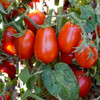Italian Roma Tomato Seeds - (Lycopersicon lycopersicum)
- SKU:
- V1177
- Seed Count:
- Approx 25 seeds per pack
- Days to Maturity:
- 73-92 days
- Type:
- Determinate
- Size:
- Plum
- Color:
- Red
- Days to Germination:
- 5-7 days @ 75-95F
- Light Preference:
- Full sun
- Plant Spacing:
- 12"
- Status:
- Heirloom, Non-Hybrid, Non-GMO seeds
Description
Italian Roma Tomato - The Secret to Rich, Flavorful Sauces
You savor a freshly picked, sun-warmed Italian Roma tomato, its deep, complex flavor the perfect balance of sweetness and acidity with a hint of earthiness and a lingering richness that invites another bite. With its bold flavor and versatility in the kitchen, it's no wonder this tomato has become a garden favorite and industry standard for tomato paste. Whether destined for a classic, luscious pasta sauce, roasted for a vibrant salsa or simply enjoyed fresh off the vine, this is a rewarding variety for any home gardener. Its compact growth habit, disease resistance, and prolific yields make it a reliable choice.
Details
The Italian Roma tomato is a bushy, determinate variety. It grows to 3 to 5 feet and spreads 2 to 4 feet, with most fruit ripening around the same time. This makes it ideal for gardeners who want a large harvest for canning or sauce-making. The tomato has a regular leaf structure and yellow flowers and is hardy in USDA Zones 3-11, grown as short-lived perennials in Zones 10 and 11, and annuals in all other zones.
The fruits are oblong or plum-shaped, bright red when fully ripe, averaging 3 to 4 inches long, and weighing approximately 5 to 6 ounces. Roma tomatoes are known for their meaty texture, thick walls, and relatively low water content, which makes them perfect for cooking into sauces and pastes. They also have few seeds, a bonus for those who prefer smoother sauces.
After transplanting, Italian Roma typically produces ripe fruit in about 80 days, including the time it takes for the plant to establish itself, flower, and develop fruit. Each tomato plant can produce a significant yield, usually around 10 to 12 pounds of fruit. With rich, fertile soil and good weather, we’ve had up to 20 pounds of fruit some years! This abundance makes them an excellent choice for gardeners who want to preserve their harvest or share their bounty with friends and family. They do best with a sturdy cage or trellis to make harvesting easier.
Italian Roma tomatoes thrive in full sun, requiring at least 6 hours of direct sunlight daily. They prefer well-drained, loamy, or slightly sandy soil. Consistent moisture prevents cracking and blossom-end rot, especially during fruiting. While they are relatively drought-tolerant once established, it's best to water deeply and regularly, avoiding overhead watering to minimize disease risk. Their compact, determinate growth habit makes them well-suited for container gardening, making them a great choice for gardeners with limited space, such as balconies or patios.
History
The tomato’s history is a tale of travel and transformation that spans continents and centuries. Its story begins in the Andean region of South America—Ecuador, Peru, Chile, Bolivia, and Colombia. From there, it made its way to Mexico, where further domestication took place. Interestingly, the tomato was initially considered poisonous in Europe!
When the tomato finally arrived in Europe in the 15th century, it had already reached an advanced stage of development. But its journey wasn't over. Throughout the 18th and 19th centuries, European growers continued to refine the tomato, selecting for desirable traits like flavor, size, and yield. They even experimented with different colors, shapes, and sizes, resulting in the wide variety we see today.
Despite its name, the Italian Roma tomato was developed in the United States in the 1950s. It is believed to be a cross between the Pan American, San Marzano, and Red Top varieties. Interestingly, the name "Roma" was chosen even though the tomato originated in the US. Continued breeding and selection by the USDA at its Agricultural Research Service (ARS) site in Beltsville, Maryland, increased resistance to Fusarium and Verticillium wilt. This disease resistance and its prolific nature have made it a popular choice for home gardeners.
Uses
Italian Roma tomatoes are renowned for their use in sauces, pastes, and canning. Unlike a slicing tomato, Roma tomatoes are not juicy, and they have thicker and drier flesh that cooks down easily into a thick sauce. Cooking also intensifies their slightly sweet tomato flavor. Consequently, Roma tomatoes are the benchmark for making sauces, pastes, and soups, although they do well in cooked and raw dishes, such as a Caprese salad with fresh mozzarella and basil. These tomatoes are equally suited to slow roasting, drying, stuffing, and baking. Their meaty texture also shines in fresh chopped salads and salsas or as a vibrant addition to omelets. They pair well with diverse ingredients, including garlic, chilies, beans, shrimp, basil, oregano, cilantro, and fresh and aged cheeses.
For the absolute best pasta sauce you’ve ever had, combine the Roma with another paste tomato, such as the San Marzano or Zapotec. The unique flavors and sweetness will complement and enhance each other, making an already good sauce outstanding!
Companion Planting
Companion planting strategically pairs different plants together to enhance growth, deter pests, improve soil fertility, and attract pollinators. For Italian Roma tomatoes, beneficial pairings include basil, which repels flies, aphids, and tomato hornworms while improving flavor; marigolds, which deter nematodes and other soil pests; onions, which repel pests and improve growth; garlic, which deters spider mites; and borage, which attracts pollinators and beneficial insects.
Some pairings are antagonistic, such as dill, which can inhibit tomato growth, and brassicas (cabbage, broccoli, cauliflower), which compete for nutrients and may increase disease risk. Potatoes belong to the same family and may attract similar pests and diseases.
Harvest Tips
To ensure the best flavor from your Italian Roma tomatoes, harvest in the morning after the dew has dried but before the heat of the day. For optimal flavor, harvest Roma tomatoes when they reach their full, deep red color and are slightly soft to the touch.
Ripe tomatoes can be injured by cool temperatures and must be stored at room temperatures, never refrigerated to avoid chilling injury, which leaves pockmarks or pits on the skin leading to early rotting.
If you need to harvest early due to weather or the end of the season, those fruits with a pink blush at the blossom end will ripen with almost full flavor. Those with the faint white lines can still ripen but won’t have the full flavor.
Learn More
- Growing Tomatoes 101
- Determinate and Indeterminate Tomatoes - What's the Difference?
- Heirloom Tomato Growing Tips
- Heirloom Tomato Leaves - Potato Leaf vs Regular Leaf
- Blossom End Rot - What To Do
- Fermented Tomato Conserve
- Sicilian Eggplant and Tomato Sauce
From the soil to the seed to the food you eat - we'll help you grow your best garden!
2 Reviews
-
Excellent tomato plant
I tried these seeds for the first time last summer and I'm glad I did. These plants were the only ones that survived the tomato wilt that hit my garden. They also produced many great tasting tomatoes-I was able to freeze them and were still eating them! These made great salsas and sauces.
-
Amazing Producers!
We grew these tomatoes in 2013 for the first time, they were so prolific I literally had more tomatoes that I could make into sauce and can! Great flavor also, thank you Terroir Seeds!!

















